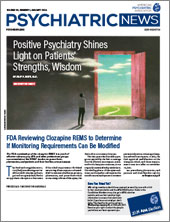MAPS Seeks Approval for MDMA-Assisted Therapy for PTSD
MAPS Public Benefit Corporation in December
announced it had submitted a New Drug Application (NDA) to the Food and Drug Administration (FDA) for
MDMA-assisted therapy for people with posttraumatic stress disorder (PTSD).
The NDA includes the results of two randomized, double-blind, placebo-controlled phase 3 studies (
MAPP1 and
MAPP2) evaluating the efficacy and safety of MDMA-assisted therapy versus placebo with therapy in participants diagnosed with moderate or moderate to severe PTSD.
MAPP1 included 90 patients with severe PTSD who were randomized to receive MDMA-assisted therapy or placebo. After 18 weeks, the mean change in Clinician-Administered PTSD Scale for DSM-5 (CAPS-5) scores in participants completing treatment was −24.4 in the MDMA group and −13.9 in the placebo group. At the end of the study, 67% of the participants in the MDMA group no longer met the diagnostic criteria for PTSD, compared with 32% of those in the placebo group after three sessions.
The second study involved 104 patients with moderate to severe PTSD—defined as a score of at least 28 on CAPS-5. At 18 weeks, CAPS-5 scores fell by 23.7 points in the MDMA group compared with 14.8 points in the placebo group. Further, 71.2% of those in the MDMA group no longer met DSM-5 criteria for PTSD after 18 weeks, compared with 47.6% of those in the placebo group.
According to MAPS, the FDA has 60 days to determine whether the NDA will be accepted for review and whether it will receive a priority review designation (agency’s goal is to take action on an application within six months) or a standard review (take action within 10 months).
Centanafadine Promising For Youth With ADHD
Otsuka Pharmaceutical in late 2023 posted
positive findings from two phase 3 studies testing
centanafadine for the treatment of attention-deficit/hyperactivity disorder (ADHD) in children and adolescents. Centanafadine is a norepinephrine, dopamine, and serotonin reuptake inhibitor.
The
first trial assessed adolescents aged 13 to 17 years, while
the second assessed children aged 6 to 12 years.
Both trials involved six weeks of treatment with one of three interventions: low-dose centanafadine (up to 164 mg daily), high-dose centanafadine (up to 328 mg daily), or placebo.
Participants in both trials who received the high-dose medication showed statistically better improvements on the ADHD Rating Scale version 5 (ADHD-RS-5) after six weeks.
“In both trials, the high dose centanafadine showed separation from placebo as early as week 1, the first post-baseline timepoint, with the effect maintained throughout the study period,” Otsuka reported.
The benefits of high-dose centanafadine over placebo came as early as one week after initiating medication. There was no statistical difference in ADHD-RS-5 scores after six weeks between low-dose medication and placebo, however.
The most common side effects observed included nausea, upper abdominal pain, somnolence, and fatigue.
OTC Fentanyl Test Gets FDA Clearance
The FDA in October cleared the Alltest Fentanyl Urine Test Cassette, the first over-the-counter test that can detect fentanyl in urine. The test can provide results in just five minutes, but the FDA noted that the test results are only preliminary; the testing package includes a pre-addressed mailing box for shipping urine samples to the manufacturer’s laboratory for confirmation testing.
“This test is an example of the FDA’s continued commitment to authorize tools that can reduce deaths associated with overdoses,” stated Jeff Shuren, M.D., J.D., director of the FDA Center for Devices and Radiological Health, in a
press announcement. “The agency expedited review of this test, making a decision on the submission in only 16 days from the date it was received.”
FDA Warns of Rare but Dangerous Risk With Clobazam, Levetacetam
In November the FDA issued a
Drug Safety Communication about a rare but serious and potentially life-threatening drug reaction to the antiseizure medications
clobazam (Onfi, Sympazan) and
levetiracetam (Keppra, Keppra XR, Elepsia XR, Spritam). The reaction is called Drug Reaction with Eosinophilia and Systemic Symptoms (DRESS). It may start as a rash but can quickly progress to fever, swollen lymph nodes, and injury to organs such as the liver, kidneys, lungs, heart, or pancreas. If not diagnosed and treated quickly, DRESS may be life-threatening.
The FDA is requiring warnings about the risk of DRESS to be added to the prescribing information and medication guidelines for these medications.
According to the drug safety communication, diagnosing DRESS is often difficult because early signs and symptoms such as fever and swollen lymph nodes may be present without evidence of a rash. DRESS can develop two to eight weeks after patients start taking the medications, and symptoms and intensity can vary widely. DRESS can also be confused with other serious skin reactions such as Stevens-Johnson syndrome and toxic epiderma necrolysis. Health professionals should advise patients of the signs and symptoms of DRESS and to stop taking their medicine and seek immediate medical attention if DRESS is suspected during treatment with levetiracetam or clobazam.
Allyx’s Lead Alzheimer’s Compound Passes First Clinical Hurdle
Allyx Therapeutics’ glutamate-targeting drug
ALX-001 appears to be safe and tolerable at all doses tested, according to
phase 1 data presented by the company at the 16th Clinical Trials on Alzheimer’s Disease meeting in Boston this past October.
This
preliminary trial, conducted by researchers at Yale University, tested six incremental doses of ALX-001 (10, 40, 70, 100, 150, and 200 mg) in 36 healthy adult participants aged 50 to 80. The compound was well tolerated, with 64% of participants reporting no adverse events. ALX-001 also demonstrated strong affinity with its target, the mGluR5 glutamate receptor.
Allyx Therapeutics is currently conducting a
phase Ib study testing the safety and dosing of ALX-001 in adults with Alzheimer’s disease, which is expected to be completed later this year. ■
